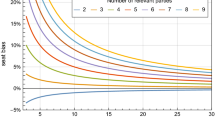Two people are holding an object ... one says all of it is his and the other says half of it is his. The first swears that no less than three quarters are due him, and the second swears that no less than one quarter is due him. The first receives three quarters and the second receives one quarter.
Talmud, Baba Metzia
Abstract
One of the few “laws” of political science is the fairly regular relationship in any given plurality electoral system known as thecube law, transforming vote shares into seat shares. In this paper, we develop an altogether different and more robust paradigm relating seats to votes which generates similar results as the cube law. In our model, political parties bargain with each other for an expected number of seats using the ability to gerrymander in determining their bargaining strength. We find that an arbitrated solution to the seat-vote allocation problem generates solutions remarkably similar to the conventional cube-law-based solutions. Thus our model can in some way replace the cube law paradigm. With our model, we are able to evaluate the impact ofBaker v. Carr (1962) on gerrymandering. We also find that proportional representation results can be achieved within our model by allowing non-zero population deviations between districts.
Similar content being viewed by others
References
Backstrom, C., Robins, L., and Eller, S., (1978). Issues in gerrymandering: An exploratory measure of partisan gerrymandering applied to Minnesota.Minnesota Law Review 62: 1121–1159.
Baker, G. (1986). Whatever happened to the reapportionment revolution in the United States? In B. Grofman and A. Lijphart, (Eds.),Electoral laws and their political consequences. New York: Agathon Press.
Barzel, Y., and Silberberg, E., (1973). Is the act of voting rational?Public Choice 16(Fall): 51–58.
Cain, B. (1984).The reapportionment puzzle. Berkeley: University of California Press.
Cain, B., and Campagna, J., (1987). Predicting partisan redistricting disputes.Legislative Studies Quarterly 12: 265–274.
Campagna, J., and Grofman, B., (1990). Partisan control and partisan bias in 1980s congressional redistricting.Journal of Politics 52(4): 1242–1257.
Cohen, L. (1991).Gerrymandering and the cube law of elections. Doctoral Dissertation, George Mason University, Fairfax, VA.
Crain, W., Davis, M., and Tollison, R.D., (1990). An economic theory of redistricting. In W. Crain and R. Tollison (Eds.),Predicting politics: Essays in empirical public choice. Ann Arbor: University of Michigan Press.
Davis, M. (1985).Legislative reapportionment in a public choice perspective. Doctoral Dissertation, George Mason University, VA.
Dixon, R. (1968).Democratic representation and reapportionment in law and politics. New York: Oxford University Press.
Dixon, R., Jr. (1982). Fair criteria and procedures for establishing legislative districts. In B. Grofman, A. Lijphart, R. McKay and H. Scarrow (Eds.),Representation and redistricting issues. Lexington: Lexington Books.
Erikson, R. (1971). The partisan impact of state legislative representation.Midwest Journal of Political Science 15: 57–71.
Grofman, B. (1975). A review of macro election systems. In German Political Yearbook (Sozialwissenschaftliches Jahrbuch für Politik), Vol. 4, edited by R. Wildenmann, 303–352. Munich: Gunter Olzog.
Grofman, B. (1990). Toward a coherent theory of gerrymandering: Bandemer and Thornburg. In B. Grofman (Ed.),Political gerrymandering and the courts. New York: Agathon Press.
Gudgin, G., and Taylor, P., (1979).Seats, votes, and the spatial organization of elections. London: Pion.
Kendall, M., and Stuart, A., (1950). The law of cubic proportion in election results.British Journal of Sociology 1: 183–197.
King, G. (1987, August).The paradox of ensuring fair representation: A stochastic model of legislative districting. Harvard University Department of Government Working Paper.
March, J. (1957). Party legislative representation as a function of election results.Public Opinion Quarterly 11: 521–542. Reprinted in R. Lazarsfeld and N. Henry (Eds.),Readings in mathematical social science. Free Press, New York, 1958.
Morrill, R. (1982). Redistricting standards and strategies after 20 years.Political Geography Quarterly 1(October): 361–369.
Morrill, R. (1987). Redistricting, region and representation.Political Geography Quarterly 6(July): 241–260.
Niemi, R., and Deegan, J., Jr., (1978). A theory of political districting.American Political Science Review 72: 1304–1323.
O'Rourke, T. (1980).The impact of reapportionment. New Brunswick, NJ: Transaction Books.
Owen, G., and Grofman, B., (1988). Optimal partisan gerrymandering.Political Geography Quarterly 7(January): 5–22.
Papayanopoulos, L. (1982). Compromise districting. In B. Grofman, A. Lijphart, R. McKay and H. Scarrow (Eds.),Representation and redistricting issues. Lexington, MA: Lexington Books, D.C. Heath and Company.
Pulsipher, A. (1973). Empirical and normative theories of apportionment.Annals of the New York Academy of Sciences 219(November): 334–341.
Riker, W., and Ordeshook, P., (1968). A theory of the calculus of voting.American Political Science Review 62(March): 25–42.
Rosenthal, H., and Sen, S., (1973). Electoral participation in the French Fifth Republic.American Political Science Review 67(March): 29–54.
Sankoff, D., and Mellos, K., (1972). The swing ratio and game theory.American Political Science Review 66: 551–554.
Scarrow, H. (1981). Partisan gerrymandering — Insidious or benevolent?Gafney v.Cummings and its aftermath. Presented at the Annual Meeting of the Midwest Political Science Association, Cincinnati.
Scarrow, H. (1982). The impact of reapportionment on party representation in the State of New York. In B. Grofman, A. Lijphart, R. McKay and H. Scarrow (Eds.),Representation and redistricting issues. Lexington, MA: Lexington Books, D.C. Heath and Company.
Shelly, F. (1982). A constitutional choice approach to electoral district boundary delineation.Political Geography Quarterly 1(October): 341–350.
Silberman, J., and Durden, G., (1975). The rational behavior theory of voter participation.Public Choice 23(Fall): 101–108.
Taagepera, R. (1972). The size of national assemblies.Social Science Research 1: 385–401.
Taagepera, R. (1973). Seats and votes: A generalization of the cube law of elections.Social Science Research 2: 257–275.
Theil, H. (1970). The cube law revisited.Journal of the American Statistical Association 65(September): 1213–1219.
Author information
Authors and Affiliations
Additional information
I am grateful for the comments and criticism of David Levy, Bernard Grofman, Charles Rowley, William Crain, and Robert Tollison. Responsibility for all errors, of course, remains mine alone. This paper does not necessarily reflect the views of the American Association of Retired Persons.
Rights and permissions
About this article
Cite this article
Cohen, L.M. The bargaining range in legislative district apportionment. Public Choice 77, 467–491 (1993). https://doi.org/10.1007/BF01047856
Accepted:
Issue Date:
DOI: https://doi.org/10.1007/BF01047856




